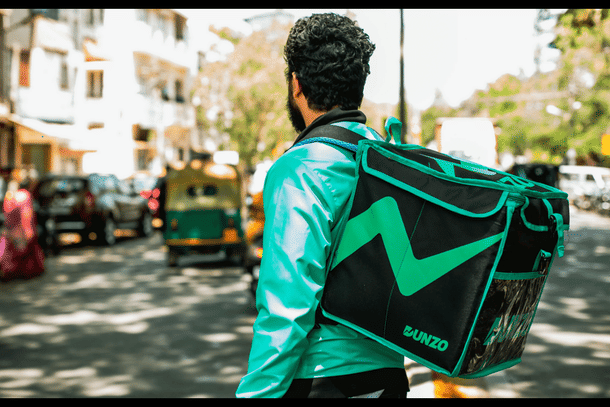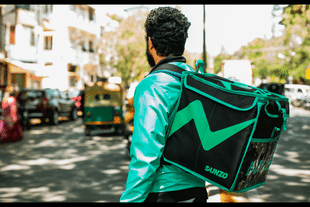Business
Dunzo Case Study: A Crisis Foretold?
Business Briefs
Jul 21, 2023, 08:47 AM | Updated 08:47 AM IST
Save & read from anywhere!
Bookmark stories for easy access on any device or the Swarajya app.


Quick-commerce start-up Dunzo has fallen into crisis and is planning to defer salaries and lay off more staff, just two months after it already laid off 30 per cent of its staff.
The move is also surprising since it had raised $ 200 million from Reliance Industries in January.
The precipitous decline in the company's health is likely due to rapid cash burn, a feature across all local delivery and quick-commerce start-ups globally.
Dunzo's competitor Blinkit had also faced similar troubles and was acquired by Zomato, which supports Blinkit's cash-burning operations with its enormous war chest.
Echoes of the Past
While Dunzo, Blinkit, Zepto, Swiggy Instamart and others are the first generation of grocery delivery companies in India, the idea itself is quite old.
In the USA, Webvan pioneered the concept of grocery delivery in 2000 during the dotcom boom. It offered deliveries within an hour or up to a week at the customer's convenience.
Several other start-ups were active in the same space back then, and almost all collapsed within a few years of being founded and raising billions of dollars.
All of them tried to compete on the lead time, increase customer convenience, offer large discounts, establish large dark store networks, appeal to mass-market customers and still failed quite miserably.
The tactics are eerily similar to those deployed by grocery delivery start-ups in India and their peers abroad.
When Dunzo started off, its primary objective was to cater to grocery demand by using contracted drivers to connect local grocery shops to consumers.
Over time, it made multiple pivots into segments like courier delivery, food delivery, B2B and others. However, its pivot into quick commerce might have been a cause of its undoing.
Dunzo entered the quick commerce segment in 2021 when everyone in the delivery space, like Grofers, Swiggy, Zepto, and others, was burning loads of cash to set up warehouses (dark stores), attract customers, and develop driver networks across urban areas.
In order to attract customers and companies had to offer large discounts and promises of "ten-minute" deliveries.
If a company wanted to deliver within 10 minutes, it would require an extensive driver network and a high density of dark stores in an area. Establishing a large number of stores would drive up costs and increase working capital requirements since inventories would have to be stocked up in these stores. That, however, is the easy part.
Impulse Purchases Make Predicting Difficult
The tougher part is to ensure high inventory turnover since a large proportion of grocery products go bad quite quickly.
While grocery shopping at a store is usually well-planned, with family members contributing to the shopping list, shoppers on quick delivery apps make no such plans. These shoppers are mainly making impulse purchases or emergency purchases, making it even more difficult for online grocery players to predict demand and stock accordingly.
Also, if all start-ups have a dark store in an area, the only factor they can compete with is the product's price and the delivery cost– both of which they have been subsidizing for a long time.
Have Players and Investors Overestimated the Segment's Market Size?
So far, start-ups are subsidizing costs for customers to gain a share from competitors and encourage customers to engage in online grocery shopping. However, the industry might be suffering from a fundamental problem.
A significant number of customers might not be ready to pay up the full cost of a quick delivery anytime soon, and investors might not be ready to keep funding the company until the market is ready.
Additionally, a dark store needs a high density of regular users near it to be profitable. Hence, the ideal market for the dark store is one with customers ready to pay up for the full cost, and the area has many regular customers.
As a result, the real size of the market might be much smaller than investors expect. Hence, investors and companies might have overestimated the current market size.
Softer Factors Could Affect the 'Convenience' Hypothesis
The primary factor that investors and companies cite for the existence of the quick-commerce business is the ease it brings to shopping, but a significant segment of grocery shoppers might not really be looking for "ease".
There are several other softer factors that one must consider – for a part of the population, especially the older one, grocery shopping is an opportunity to socialize.
For others, including the younger audiences, weekend shopping at the local supermarket itself might be an enjoyable experience. At best, such audiences would be occasional users of quick commerce platforms looking for something they need quickly.
Quick-commerce companies are already pivoting away from the older delivery model.
For starters, promises of 10-minute deliveries are being slowly taken back, with time limits extending to 10 to 20 minutes. In addition, they are attempting to club multiple orders together to make deliveries cheaper and reduce the number of dark stores to help only the viable ones survive. Order sizes, too, are being increased for a user to be eligible for free delivery.
Lessons from Webvan's Collapse
While some of Dunzo's problems might be idiosyncratic, a larger part of its problems is a sign of problems the entire sector faces.
The initial market size assumed by quick-commerce companies and their investors are most likely overly-optimistic, and they offer a service only a few can pay up for regularly.
Quick commerce itself might not be as scalable as some think and is likely to survive in a different form on a much smaller scale.
The criticisms faced by Webvan are also the ones faced by the current crop of quick delivery start-ups.
Webvan and its peers too focused on the mass market rather than niche markets where its services would be profitable. The companies that survived the dotcom collapse grew at a slower pace by focusing on niche markets and using supermarkets as "stores" instead of establishing their own "dark stores".
Indian quick-commerce start-ups could learn from their predecessor's mistakes and align themselves accordingly rather than pursuing unsustainable growth based on wrong assumptions about the market itself.
Also Read:
Explained: The Struggle And Slowdown Of Quick Commerce Space





